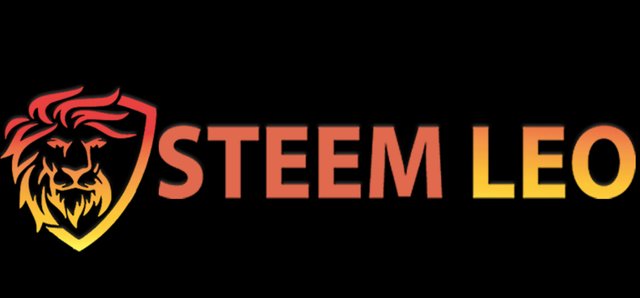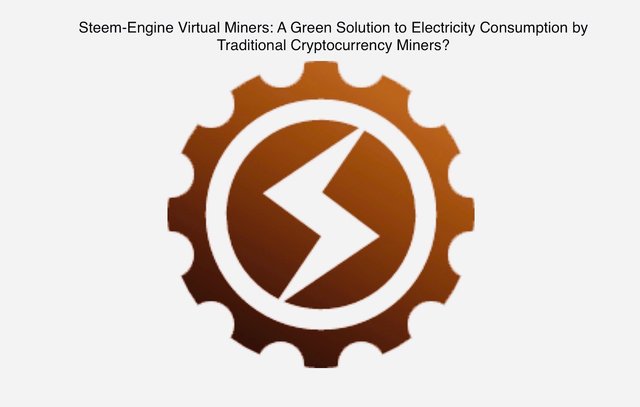Steem-Engine: Virtual Miners: The first Green Cryptocurrency mining technology?
Virtual Mining is a term given to a new way to mine cryptocurrency. These miners are called virtual miners and they are able to “mine” cryptocurrency “Tokens”. Currently, the only virtual miners I know of are for cryptocurrency Tokens based on the Steem blockchain “sidechain” called Steem-Engine. The purpose of this post is to explain how virtual miners may be a green alternative to traditional miners. But in order to understand my explanation, I think some background information and definitions are needed. Then we can all start from a common point of understanding.
Blockchain
Blockchain is a technology that allows individuals and companies to make instantaneous transactions on a network without any middlemen (like banks). Transactions made on blockchain are completely secure, and, by function of blockchain technology, are kept as a record of what happened. Strong computer codes ensure that no record of a transaction on blockchain can be altered after the fact. Source
Bitcoin
Created in 2009, bitcoin is an all-digital “cryptocurrency” that doesn’t pay attention to banks, governments, or international borders. There’s a cap of 21 million bitcoins—so inflation is not possible—and the current bitcoin market is valued at $298 million, with each bitcoin clocking in at around $3,516 right now. By using blockchain technology, the inventor(s) of bitcoin (a mysterious person or group known only as Satoshi Nakamoto) gave their currency the ability to exist without some sort regulatory oversight. Every person who participates in the bitcoin network—everyone who buys with, sells in, or owns bitcoins—has their own copy of the bitcoin blockchain. Whether you’re an individual buying a lemonade or a multinational lemonade company selling your beverages, each transaction you add to the blockchain is checked against everyone else’s blockchain ledgers. This system prevents anyone from using the same bitcoin more than once—which was the biggest problem with all-digital currencies before bitcoin came along.Since bitcoin is a purely person-to-person digital currency model, anyone using bitcoin can make fast, secure, low-fee transactions whenever they want, to anyone in the world. It’s a universal currency. Acquiring bitcoin is as easy as buying some (like exchanging money for foreign currency) or accepting some from others (if they want to buy your lemonade in bitcoin, for example).
Source
Miners for Bitcoin or other cryptocurrency miners.
Bitcoin Miners and Your Financial Security
The market for cryptocurrency like Bitcoin spans the entire Earth! The blockchain or ledger of all transactions has to be monitored? And that is where people called “cryptocurrency miners” enter this picture. People called bitcoin miners get paid in bitcoin in exchange for running complex algorithms on their super-powered computers to verify bitcoin transactions for other people. Bitcoin transactions are subject to very small fees that add up to pay these miners. These “miners” make it possible for a global blockchain to support this all-digital, no-regulation currency that anyone can buy or sell. So these miners aren’t really people who dig in the ground. So the machines are called miners and the people who own the machines are also called miners, meaning they are the people who have the machines which due the actual mining.Source
Sidechain
A sidechain is a separate blockchain that is attached to its parent blockchain using a two-way peg. The two-way peg enables interchangeability of assets at a predetermined rate between the parent blockchain and the sidechain. The original blockchain is usually referred to as the ‘main chain’ and all additional blockchains are referred to as ‘sidechains’. Source
Steem-Engine is a software application created by
@yabapmatt and @aggroed, in partnership with @harpagon, are launching a platform and accompanying website called Steem Engine (https://steem-engine.com) with an initial focus of allowing the creation of custom tokens on the Steem Blockchain. So a big Thank you to @aggroed @yabapmatt @harpagon @asgarth
Source: @aggroed
Smart Contracts on a Steem Sidechain
Steem Engine uses the Steem Smart Contracts software, built by @harpagon, which is a smart contract enabled sidechain platform built on top of the Steem blockchain. Initially we're launching with a limited set of smart contracts enabled which allow anyone to easily make custom, simple tokens on the Steem blockchain.
Source: @aggroed
Vitual Mining ⛏
The mining of cryptocurrency is as old as Bitcoin itself. It started with what was called CPU mining using existing hardware on regular home desktop computers. However Bitcoin mining was built to increase in difficulty over time and as the measurement of time called “blocks” went by, regular home desktop computers were unable to effectively mine blocks. Thus began an “arms race” of a type where people built increasingly powerful computers, which performed computer tasks, but also mined Bitcoin. Slowly these machines evolved to be better and better at mining and gave up their regular computer functions. Soon they were only able to perform only one function; mining Bitcoin. These machines stopped being called computers and were simply called miners. Bitcoin’s success encouraged the development of other cryptocurrency projects like Litecoin and Ethereum, and others followed until there were over 2000 cryptocurrency coin projects. The vast majority required powerful, single purpose machines called miners, that consume electricity, generate heat and are noisy. The heat has become enough to heat rooms in the winter and the noise enough to generate complaints from neighbors, so some build special enclosures with fans and vents to deal with these side effects.
The electricity consumption has lead to some towns and municipalities passing laws to charge the owners of cryptocurrency miners more for electricity and some have banned them. Which has caused some to move their mining operations to places with geothermal electricity, which is free or very inexpensive and often the cold climates and relative isolation of these locations deal with the heat and noise issues too. It is because the mining of Bitcoin and other coins is so profitable, that these mining operations are increasing found all over the world; the consumption of electricity by these businesses has become a concern for some who think that is a bad thing.
While the majority of businesses from bakeries, schools, factories and even hospitals consume electricity and produce products, for which they earn a profit; cryptocurrency alone has generated special interest and criticism for energy consumption. It is with these issues in mind that a different type of cryptocurrency “mining” was invented, called delegated proof of stake or DPOS, of which Steem is an example. In this cryptocurrency model there are are a fixed number of people able to mine the currency for rewards. The rest of the people earn cryptocurrency through some other indirect method, which doesn’t involve “mining hardware”. This new model is growing in popularity and one of the more famous cryptocurrency projects called Ethereum is considering changing to a DPOS model for this reason.
The newest model for mining cryptocurrency is virtual mining or virtual miners. In order to understand the significance of virtual mining you need to compare it to non-virtual mining of cryptocurrency. There are currently two general types of cryptocurrency coin miners that I know of at this time. First; Physical miners: which are basically specialized computers, which are actual physical machines, using electricity, giving off heat and noise and moving parts. Second; Virtual miners: which in contrast to physical miners, they have no physical form, they are instead “virtual” in that they exist only as “software constructs” in the digital world of computers. Which ironically means they are the same conceptually as digital currency, like Bitcoin, Litecoin, Ethereum and Steem. These cryptocurrencies only exist in the digital world. So in other words Virtual miners mine Virtual cryptocurrency. Currently, the only ones I know of are for cryptocurrency Tokens which are based on the Steem blockchain “sidechain” called Steem-Engine.
Conclusion
These virtual miners may be the next stage in the mining of cryptocurrency, because with virtual mining and virtual miners, there are no machines to consume electricity, give off heat or noise and they require no repairs! I have built and run physical miners and I did derive a strong sense of pride from figuring out how to build the and run these physical miners. They were noisy, hot and consumed a large amount of electricity. The whole world is looking for solutions to problems inherent in industries based on fossil fuel generated electricity, so “green” or earth friendly solutions are very popular. So I think these Virtual Miners are the Green solution for cryptocurrency miners.
I hope you found this both exciting and helpful.
✍🏼 by Shortsegments.
Reference for further reading
https://steemit.com/steemengine/@aggroed/introducing-steem-engine-com
https://steemit.com/steemengine/@aggroed/introducing-steem-engine-com
https://hackernoon.com/what-are-sidechains-1c45ea2daf3
https://www.fundera.com/blog/blockchain-explained

RealityHubs.com
RealityHubs is a place for reviews.
Learn more about this new project Here! .



Source
Steemleo is a community for investors or people who want to learn about investing!
Click here for more informationj



PhotoStreem: a place for people interested in photography
PhotoStreem

You present a very good explanation all the way up to explaining how a virtual miner actually creates value for the holder of the mining token. Even a link to a white paper on the topic would be helpful.
As you said, a physical mining machine is solving a difficult problem (mostly by brute force) that securely adds a block of data to the blockchain and in return, the system rewards the block-finder. But what does a virtual miner do to earn its rewards? If it is just another form of staking, then it really isn’t mining in the same sense that a proof of work (PoW) miner does. I realize that is really your point, but fell short of completing the argument, unless I missed something.
If a virtual miner is more than just a glorified staker, how is it different? For example, besides the rate of return, how is leom different than powering up basic leo? What additional ’work’ is it doing to earn its keep, so to speak.
That’s what I was hoping to learn from your otherwise informative post.
Hi
Thank you for the compliment, and for the questions.
I will find the answers and create links or new post
Thank you for reading my post and I appreciate your feedback.
These are very good points. I must research these questions because I assume these are mining since they are competing for blocks and I assume they are helping to secure the network. But know I have two assumptions and no supporting data. This leaves one very big question; How do they actually work?
I will pursue the answer.
Thanks
Thank you for the explanation and the references.
Thank you for the feedback
Posted using Partiko iOS
Thanks for sharing this info.
Cheers!
Hi
I am glad you found it useful.
Thanks fir your comment.
I think a lot of people would argue that it isn't mining because no resources are spent and (more importantly) it doesn't secure the network.
POW 'wasting' resources isn't a bug, it's a feature. It allows anyone around the world to turn raw electricity into actual currency. Resources being consumed give the currency that much more value.
Variety is the spice of life. Both POW and POS are valid forms of consensus each with strengths and weaknesses.
Hi
These are very valid points, I will have to research this idea that they don’t secure the network. Very interesting. The description fir the miners says your competing for blocks, so now that you told me this I have to dig deep and see where I am misinterpreting this to mean actual mining.
I agree with you that POW isn’t a waste of electricity, it is a use of electricity. No one says using electricity to watch TV shows which create no value are a waste, but the world stage is full of subjectivities.
Thanks for your comment and stimulating me to learn more.
Posted using Partiko iOS